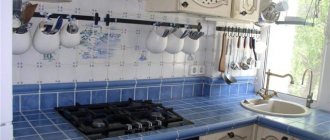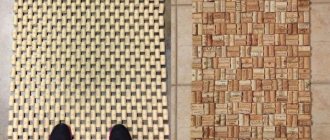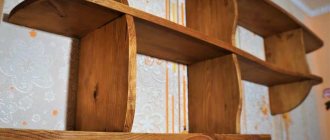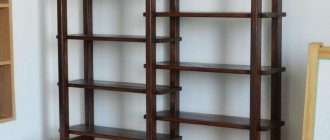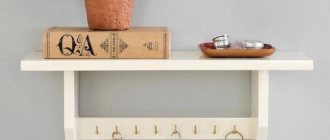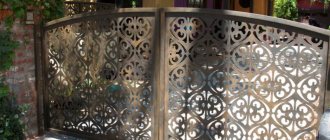Hi all! Today we have an unusual, but very interesting topic for discussion. We will talk about furniture with hiding places.
Each consumer has approximately the same requirements for purchased furniture items. It is important for a person that they fit into the interior of the room, have the necessary functionality and are as practical as possible.
But for some people, having secret places is also important. That is, such compartments and cavities in furniture that no one knows about and is unlikely to find out. It is antique furniture that is famous for the presence of various hiding places, which previously were an urgent need to hide valuables, jewelry, papers and just money.
Now many people are also interested and important to receive such pieces of furniture with secrets. There are actually two options. Buy a finished product, or make it yourself.
Secrets in furniture
The coffee table uses the space between the lid and a false bottom panel to hide a pull-down drawer. Access to the secret compartment release lever is provided through an opening in the middle of the drawer.
The lever is suspended from a jumper that connects the front and rear aprons of the table. When one end of the lever is pressed, the other end presses against the slotted wood block and rotates the false bottom panel.
The slot allows the drawer to move up and down.
The panel is suspended from the back of the table on two card loops. In the closed position, it is secured with latches with two balls and a spring-loaded strut.
A brace made from a strip of 3x12mm brass also serves to secure the panel in the open position.
The drawer is attached to the bottom panel using a central sliding system that allows the drawer to be pulled out once the panel is lowered.
The drop panel concept can be used wherever there is free space and access from below. This design is ideal for tables and tables with aprons that create a cavity under the lid.
Mantel clock with a secret
The small mantel clock has a hidden drawer in the base. It is made using a frame/panel design and the panels (the sides of the drawer) are recessed slightly to hide the seam around the perimeter. The drawer, when not locked, can be pulled out in any direction (left or right). In the closed position, the drawer is secured with a simple pin mechanism.
The base is attached to the body with one screw, offset to one of the sides. This allows the body to rotate relative to the base. On the side opposite the screw, a triangular recess is selected in the bottom of the housing.
A spring-loaded pin is then installed into the base of the clock, resting on the lower end of the triangular recess. The spring is held in place by a small washer soldered to the pin.
When the watch case is turned slightly, a spring-loaded pin rises into a triangular recess, emerges from a groove in the side of the drawer, and releases the drawer.
To avoid accidentally turning the watch in the wrong direction, you need to insert a locking pin into the base, which fits into a rectangular recess in the bottom of the watch case. It is smaller in size than a triangular depression and does not have a point. Therefore, the pin will serve as a stopper to limit rotation in both directions.
This type of secret drawer can be used in designs where the top section pivots over the bottom.
Gothic bureau
On a Gothic bureau, the sloping back panel of the lid became the door to the secret compartment. Since the door had to hang on hinges, it was necessary - if possible - to make the gap around the door invisible.
In combination with a neat fit of the rear panel itself, this is ensured by the installation of card loops and decorative tape around it. The door to the secret compartment is opened by a cable mechanism driven by one of the bureau partitions.
Its advantage is that the cable can be easily pulled from the partition to the door without the use of complex devices. When closed, the door is secured with brass latches with two balls. When the partition moves towards the wall, the tip of the cable presses on the door and it opens.
The opening system includes a built-in return spring that automatically returns the partition to its original position.
This cable-operated idea can easily be adapted to any secret compartment panel as long as the product can use a pusher to open the door.
Secrets of the nightstand
The next two secret compartments are more difficult to make, but also harder to find. In this design, the button for accessing the secret drawer is the tooth of the molding. Even if you know there is a secret compartment, it is unlikely that you will discover the mechanism that provides access to the long, narrow drawer hidden in the lid.
The scalloped molding that runs along the entire perimeter of the nightstand is a great place to hide the drawer opening mechanism, since the button is one of the prongs.
When the tooth button is pressed, two pins are raised and the drawer is released. The button is connected to the pins through a connection made of a rigid brass plate 3x12 mm.
The drawer is hidden behind the molding just below the tooth, as a section of this molding serves as the front wall of the drawer. When the tooth is recessed, the pins rise and unlock the drawer. A spring installed behind this drawer extends it far enough so that the front of the drawer can be grabbed by hand and pulled out completely.
Materials for assembling a simple bedside table
To assemble furniture according to the project I developed, I needed the following:
- Set for creating hidden connections.
- Wooden dowels with a diameter of 1 cm, connected in 5 pieces.
- Wood glue.
- Clamps.
- Electric drill.
- Pull-out guides for a 25 cm long drawer.
- Metal hinges for the top cover.
- Clamp.
Below I list the main steps for building a nightstand.
Save the most valuable: 10 ideas for hiding places in furniture
Despite the fact that today most of our valuables and secrets are stored on a bank card and on password-protected sections of computers, sometimes at home we need a real hiding place for small but important things: grandmother’s jewelry, very personal papers, a large amount of cash, in the end , an emergency supply of chocolate. Let's see what professional designers and craftsmen offer us.
Designer Yi-Ting Ching managed to create just exemplary hiding places for his Secret Stash project. Hollow, but solid-looking wooden furniture parts, as well as a milk glass under which you can hide keys, and a lamp for storing money - a complete set of secret places for all occasions.
Another example of great design is the Hide stool from Swedish designer Tove Greitz. To open the cache, you need to solve the puzzle by moving the wooden panels in the correct sequence.
An elegant solution was invented by the Japanese studio Torafu Architects. The Clopen Shelf contains a secret drawer that can only be opened using special magnetic handles. Magnets can be carried in your bag or used as key rings.
The shelf, created by designer Daniel Schofield, has a simpler design. On the one hand, the hiding place seems less reliable, but on the other hand, there are no seams or cracks on the visible surfaces of the shelf that could indicate its hidden essence.
Our favorite idea in this collection is a drawer within a drawer. It reminds you of fairy tales and palace secrets at the same time. True, the box is so tiny that you can only put the key to a more spacious storage room there.
The table created by designer Max Lamb for Benchmark doesn't pretend to be a piece of furniture with real secret storage, but the hidden compartment can be disguised simply by covering it with a tablecloth.
Fresh design ideas are good, but they do not negate the dignity of the classics. What is a classic cache? That's right, a box with a double bottom. In order to create it, you do not need to have special carpentry talents, a good master class is enough.
You can store important things in the bedroom, but not under the mattress. A hollow bedpost, for example, would be better suited for this.
Or its headboard, as offered by Secret compartment furniture, which manually creates pieces of furniture with secret compartments.
So, hiding places can be made everywhere. Let us list once again the most accessible options.
In boxes.
We hardly use the space in the back of dresser drawers and desks, so you can create a hiding place there by making a double wall. Remember that the smaller our secret compartment, the more difficult it is to notice. Another option is to make a double bottom. If it is not made of plywood, but of thick material, you can cut a recess in it and cover it with a second, thin and durable layer. Then the cache will be almost impossible to detect.
In the closets.
A hiding place can be arranged in the space between the floor and the bottom shelf of the closet. If it is impossible to remove the “plinth” panel in order to simply put valuables under the cabinet, sacrifice the integrity of the bottom: you can carefully cut out a “hatch” in it, which will provide access to the space near the floor. Build a box according to the size of the hole and the height of the gap between the bottom of the cabinet and the floor, and try to make the hatch itself as inconspicuous as possible.
Cushioned furniture.
A hidden zipper in the seam of upholstery or pillows allows you to temporarily hide small valuables in the furniture. If you want to feel like the hero of the movie “12 Chairs,” just sew valuables under the fabric. The main thing is to choose threads that match and make sure that the chairs or sofa are not accidentally sold or thrown away.
Use over the full head of the bed
The head of the bed can be used more rationally, because it can hold not only a pillow during sleep or decorate the interior. There are models of beds that already have secret drawers for bedding built into the headboard, but craftsmen can do this themselves. And if you can’t fit pillows or blankets into them, then you can definitely create a hiding place with the most unexpected things.
Article on the topic: Do-it-yourself furniture from profiles
Stage one: creating the frame
If you are using artwork that is already framed to create the hidden cabinet, you should skip this step.
You need to do the following:
- cut the boards to the required length;
- cut out grooves for glass, if its presence is required;
- file their edges at an angle of 45 degrees;
- glue;
- secure the mount using hardware located in the pocket holes;
- clean off any excess glue with sandpaper;
- decorate the finished frame.
If a system of pocket holes is not at hand, then it is quite possible to fasten the frame using furniture corner brackets. In this case, thin and short screws will be needed. It is convenient to use self-tapping screws.
Happy together for 17 years: new photos of Konstantinov’s wife from “Strong Armor”
Oscar Kucera's third wife looks great after her fourth birth (new photos)
The Internet is debating whether it is possible to distinguish an alpha male by his pose in a photograph.
The next step is to secure the glass. Paintings don't require glass, but watercolors or photography do. Instead of ordinary glass, you should use thin fiberglass, such as is used in the manufacture of photo frames. This material bends. It just needs to be inserted into the grooves. If you want to use simple glass, then it needs to be inserted into the grooves before assembling the frame.
The final step is to frame the artwork and secure the back panel. The backdrop needs to be cut out of plywood, sanded and decorated. The back panel is attached to the frame with hardware or glue.
An important point: when using wood glue, you will need clamps to fix the position of the parts.
Narrow drawers
If the furniture was not made to order, then there will definitely be a narrow place that can also be used to advantage. And it doesn’t matter what kind of room it is: on a narrow pull-out rack or shelf (it all depends on the area) you can store from tubes of cream to jars of preserves.
Important: Such shelves can be made independently, and their creation does not require the qualifications of a carpenter; a minimum set of tools, the availability/purchase of any wood-based material, furniture wheels and fasteners will be sufficient.
Visible but hidden
Which of your house guests would think that there is a hiding place behind the mirror? We hope no one. Everyone will see themselves in the reflection, but will not even suspect that something may be hidden behind the mirror. If you make a small box and “sink” a mirror into it, the structure will seem solid, because the mirror will not stick out. In the resulting space you can store especially important documents and any valuables you have. In order not to complicate the finishing work, you can skip the step of creating a box for the mirror. It is enough to buy a thick mirror and a chic frame for it, and the frame should be thick enough so that the mirror seems to lie on it. In this case, there will be a gap between the wall and the mirror where you can put spare keys, jewelry that is not used daily, and other small items.
Toilet
Surely you immediately thought of placing a bag of money and jewelry in the drain tank. This hiding place is already known to thieves, so there is no point in taking risks. You need to use a float that regulates the water level. Turn off the water, carefully remove it from the tank and cut it to make a storage container (for example, a pretty decent rolled up wad of money will fit in there). After this, glue the cut improvised lid with superglue or weld it using a lighter or soldering iron (the heated parts of the plastic will easily melt and stick).
How to make a hiding place in a desk drawer with your own hands
Every person has something to hide from others. Even a squirrel hides nuts for the winter so that another squirrel cannot find them. And since time immemorial, people have made hiding places, including in their homes. Times changed, morals changed, furniture changed. And the man came up with hiding places in desk drawers.
Types of caches
Hiding places can be created anywhere in the house. But most often they are built into furniture. In fact, hiding places can be arranged not only in desk drawers. Hiding places are made in furniture legs by drilling holes there.
At the same time, you need to make sure that the legs do not lose strength, otherwise the table will collapse! You can make a secret place under the tabletop or in the seat of a chair. It is very convenient to build hiding places into large cabinets and bedside tables. They are built into the side walls, into a thick tabletop, made with hinged doors and retractable. How much imagination is enough, and how much skill is enough.
Hides are made either with secret locks or with their own locks. Modern locks are often opened with magnetic cards, which have been in great demand in recent years.
Stash in a desk drawer
The hiding place in the desk drawer is very convenient to use, very easy to make
And, importantly, with careful manufacturing it is not noticeable
Making it is quite simple. Four small objects, 2–3 cm high, are glued to the bottom of the box selected for modernization in the corners. The volume of the secret space inside the box depends on the thickness of these gaskets.
In order to open the secret part of the box, you need to do the following. Four small holes are drilled in the actual bottom of the box. They are located in pairs against the middle of the side walls at a distance of 2 cm from them. A hook is prepared from a rod with a diameter of 3–4 mm. The long part of it is inserted into the hole from below and the false bottom is raised. Then they hook it and pull it out.
Of course, experienced thieves and robbers know where to look for hiding places. But there are also professional mystery creators who come up with new riddles. This eternal struggle leads to new original solutions.
Hide behind the mirror
As a rule, mirrors occupy a significant part of the vertical surfaces and practical people have also found a use for them. If you place a large mirror not just on the wall, but make an appropriate structure under it and attach piano hinges, you will get a secluded place to store hygiene products, small items or jewelry. Everything will depend on the location and width of the box.
Article on the topic: DIY MDF furniture
Marking and cutting MDF
First we cut out the top cover. To do this, we place the stand on the sheet with its side so that the back side of the future cover is flush with the horizontal shelf. The front side of the cover should protrude forward beyond the horizontal shelf by 1.5 cm. Mark the position of the first part of the shelf.
Mark the outline of the lid
We turn the stand over and mark the position of the second, mirror part of the shelf.
Cutting out the top cover
We cut out the top cover with a jigsaw, installing a file in it for a curved cut. The pendulum stroke must be turned off during operation. The dimensions of the cover should be:
- Length – 890 mm,
- Width at the junction of horizontal supports – 320 mm,
- The width at the ends is 170 mm.
We cut out the back wall in the form of a rectangle, according to the given dimensions - 890x325x16 mm.
Scheme of our secretary
We sand the finished lids and coat them with furniture varnish 2-3 times or cover them with self-adhesive film.
Each time dictates its own styles, including in furniture design. However, in addition to beauty, many interior items should also have additional functionality: have drawers, drawers and shelves. And in some cases - hiding places, small safes disguised as ordinary bedside tables, chests of drawers or other pieces of furniture, as well as built into bookcases and wardrobes.
Secretary with curved legs, decorated with carvings
Their presence always had its own meaning: here it was possible to hide something that was not necessary for others to see. And, starting from the 18th century, in any rich house one could find a secretary, or in the Russian version, a desk where the owner kept especially valuable documents: bills, money, jewelry.
Various hiding places and secret drawers are often discovered inside antique furniture that has survived to this day.
Furniture with secrets - table and cabinet with additional drawers
In past centuries, in the homes of wealthy people, a mandatory part of the office was a table or a cabinet with secret drawers, which were used to store especially important documents, money, and jewelry, which made it possible to protect them from thieves. Later in France, a special table-cabinet was invented, called a secretary, because it was really possible to store various secret documents and small valuables in it.
The drawers were often equipped with secret locks and secret locking mechanisms
The popularity of secretaries and other furniture “delicacies” equipped with various secret spaces was not accidental. Their design has its advantages that ordinary tables and cabinets do not have, and features that are unique only to such products.
They are no less relevant today: valuable papers, expensive jewelry, important correspondence and documentation are stored in stylized safes and hiding places. Among the obvious advantages of such furniture are:
- storage of valuables without access to them by strangers;
- their arrangement in different furniture elements;
- the possibility of making secret storage facilities with your own hands.
Among the factors characteristic of furniture with a secret, the design features of such products are highlighted, making it possible to prepare places for storing a specific type of valuables. As a rule, if hiding places are specially equipped, they are equipped with secret locks, and today - with an electronic security system.
Today, the furniture market offers products not only for personal use, but also for enterprises and organizations. In addition, it can be made to order according to individual drawings.
To open this table you need to place a special magnet in the right place, there are no more handles or levers
Cornice
If your home does not have round curtain rods (very often these are used in certain interior design styles), pay attention to the curtain rod that holds the curtain in the bathroom. Such a “pipe” will definitely be hollow inside, so there is nothing easier than removing the side holder and placing a rolled up stack of bills in the ledge. Since it is possible to fold valuables on both sides, be sure to take advantage of it (for example, you can fold not only money, but also jewelry placed in a small bag or pouch).
A few tips and rules
First of all, you should understand where you should not store valuables, documents and money.
Important! The main rule is not to store all funds, papers and expensive items in one place.
Avoid using classic hiding places: mattresses, mirrors, paintings - they will be the first to be examined in the event of a robbery. Also, traditional hiding places in which most thieves find valuables are: drawers of chests of drawers, bedside tables and cabinets, including those with double bottoms, mezzanines, kitchen jars, books, musical instruments, such as pianos. Do not make hiding places in household appliances, especially video and audio devices, as there is a high probability that they will also be taken away during a robbery.
In the photo below you can see some fascinating statistics about where people usually prefer to hide things:
Popular hiding places in the house.
The hiding place should not be obvious and most often it is placed in a visible place. But the main thing is that this object does not catch the eye and its appearance does not stand out from the overall picture. Then no one will think of checking your homemade safe!
Chess, aerosols, batteries and other little things that are always in sight
As a rule, familiar household items that are in plain sight are the last to come under suspicion and arouse increased interest from thieves. For this reason, enterprising owners are able to turn an ordinary battery, deodorant can, shaving foam or cream into a reliable hiding place for money/light items.
Collectible chess sets with a board, family photographs framed and books look especially original, no matter how banal it sounds. First of all, thieves begin to gut books, you say, but if you approach the process wisely, you will be able to create a hiding place that is not “afraid” of such blasphemy. This method will be especially effective if the house has a large library.
Screen in everyday life
It seems that the screen in the middle of the room has finally gone out of fashion. However, screens can be used in our daily lives. They allow you to partition or close something.
Our first recommendation concerns a screen that can be used to create a comfortable workplace. Two workstations in a narrow children's room, equipped with a side to the window, give two children the opportunity to study without distraction. The partition can be made from old material you have. If we are building a new partition, it is recommended to make a frame from slats (2 cm thick and 6–7 cm wide), interconnected at the ends with an overlap. If a large structure is planned, it is necessary to provide transverse rigid fastening, especially if we (as indicated in Fig. 21) also want to equip small shelves on the partitions.
Rice. 21. Screen
We carefully sheathe the frame on both sides with TDVP. We make small shelves from pieces of boards 12–15 cm wide, nailed together at right angles. The shelves should be positioned in such a way that they are supported by transverse connections, which are secured with screws screwed into the other side of the partition. Since the shelves are not opposite each other, you can hang a tear-off calendar or attach a writing board on the screw heads on the other side.
At certain intervals we screw in small hooks. We attach lamps to the top of our structure to provide the necessary lighting. In order for the partition to have a strong support, support bars are used as legs (as can be seen from the figure).
Another option for using a screen is shown in the figure below. The screen can be used by placing it in front of the crib to protect from light and noise. It is also useful in the garden to temporarily fence off, for example, a swimming pool. To do this, we build frames approximately 180 cm high, which are upholstered on one side with any padded material. The upholstery can be mats, straw matting, awnings, burlap (which, by the way, can be painted in a very original way) or even cardboard, which can be covered with wallpaper. The frames form a screen using plug hinges.
To use the screen outdoors, we attach two long pegs at the bottom of each frame that stick into the ground. By using tent pegs (as indicated in the right picture below), the screen is installed so firmly that no wind will blow it away.
Bedroom. Shelves inside the headboard
If you don’t want to fill the space under the bed, you can use a headboard: both ready-made designs with built-in drawers and free-standing narrow cabinets are sold. It is very convenient to store things in special compartments - they do not gather dust and are always at hand.
Article on the topic: Do-it-yourself transformable wooden furniture
In addition to books, you can store night cream, small decorative pillows, a change of bed linen or a blanket inside.
Website about repair and construction » How to make a hiding place in a wooden floor with your own hands
Category: Repair › Floor › Foundations, starting work, preparation, general tips
In fact, you can make a hiding place with your own hands in every place of your own home: the design of windows, the ceiling, various pipes, etc. Let’s look at the step-by-step creation of a hiding place in a wooden floor with your own hands.
Choose the place wisely To make an invisible hiding place under the floor you need to try hard. Now there are different points of view about how, of course, it is best to make a hiding place in a wooden floor.
Still, most experts advise choosing not the middle of the room, but one of its edges for the production site for the hidden cavity.
There is a logical justification for this position: if you do not have time to hide the lid from prying eyes, the cache located in the center of the room will quickly give itself away.
Also, in the place allocated for it, the floor may sag, and when walking on the floor covering, the specific sound of footsteps will indicate that there is emptiness under the floor.
As a result, it becomes absolutely clear that the most pleasant place to make a hiding place is considered to be the edges of the room, because people move along them least often.
And this especially applies to corners. You can also increase the inconspicuousness of the cache. To do this, install some piece of furniture on it. So, for example, a chest of drawers or a safe, which are often placed along one of the walls, can not only close the lid of the hiding place, but also firmly press the carpet to the floor, so the secret cavity will be kept secret from prying eyes.
As a result, even if, for example, criminals carry out a search and they do not have enough time, it is unlikely that they will find your jewelry. It is worth stating right away that real specialists will be able to simply identify such tricks, but, again, with the required amount of time.
What you can focus on The nature of the floor can, in some categories, help you in choosing the location of the hiding place. It is clear that if a carpet, for example, can be used for conspiracy, it is only superficial
But a floor made of parquet or vinyl tiles with a pattern of joints will be a particularly convenient option: With its help, you can professionally achieve the desired outline of a hiding place hatch.
A hiding place placed in a living space can simply put money, papers, disks, but for very large items it is better to find another place. Making a hiding place in a wooden floor with your own hands Let's look at how to make a hiding place in a wooden floor with your own hands.
First, keep in mind that producing a competent cache is considered a fairly thoughtful endeavor because its features do not need to be visible to uninformed people. In order to make a hiding place in the floor, you need this material: wood glue, plywood two centimeters thick, painting, circular saw, self-tapping screws, nails, compressor, jigsaw, hammer.
In addition, you will need the following tools: tape measure, screwdriver, roller, sander, level, brush, square and plug drill. Only when everything you need is at hand can you begin to work. First, choose a suitable hiding place in the wood floor.
Set the required depth of the flooring on the circular saw, which is often equal to two centimeters. Later, you need to cut out a small hole in order to understand what is being installed under the floor of your home. Try to preserve the integrity of the logs.
The insulating material that is placed under the decking can be removed or moved to the side.
Mark the future cache and cut a hole for it. Of course, it is best for it to be located between the joists. The hole should be in the shape of a rectangle.
And after this you need to measure the resulting cache
- this will help determine the size of the future box for storing your treasures. To make the walls of the cache, you can use plywood, which is connected with glue and nails. Try to create a box so that its dimensions are slightly smaller than the hole you made. And after that you can paint it.
You can create this using a plug drill.
If you have completed all the steps listed above, you will be able to make a hiding place in a wood floor with your own hands. Now worry about his strong secrecy and take advantage of his well-being.
Table stand
The stand is assembled from six side walls. They are made of 15 mm thick MDF and are veneered on the outside with radially sawn maple veneer. The vertical edges of the walls are sawn at an angle of 60 degrees. Having temporarily assembled all six walls, the master determined the dimensions of the upper and lower supports so that they would fit accurately into the rack. The supports are made of MDF. They have holes drilled and countersunk for screws.
Then the master cleaned the inner surfaces of the walls, sealed the joints, coated them with wax and polished them. The stand - walls and supports - are assembled with glue using window clamps and clamps for picture frames. There is no need to glue one of the walls, which should become a door.
When the glue hardened, the master removed the door - and there were five walls attached to hexagonal bases. Using a hand plane, he chamfered it to create a 4mm wide edge. I glued strips of tulip edging to them with PVA glue and pressed them with adhesive tape until the glue dried.
Hiding places in ordinary furniture
The simplest example is if you need to securely hide an envelope or a flat package, simply tape it to the bottom of the drawer on the bottom side. In most cases, even if someone goes through all the drawers of your desk, they will hardly think to look under them. For greater confidence, use the lowest drawer so that inspecting its bottom is also physically inconvenient.
The same principle applies to hiding places under the seats of chairs, however, in our opinion, this is less reliable: chairs are often lifted to be rearranged, and they can also accidentally fall. Therefore, there is a very high probability of quickly discovering such a cache, and it is better to use this original storage method for something not very valuable.
It is also quite common to store valuables in a piano. By its design, this musical instrument has a lot of free space inside, which can be perfectly used to place anything: from household supplies to important documents. Of course, provided that there is no professional musician living in your family who will not allow you to treat the instrument so frivolously.
Hiding places are often installed under furniture - in the empty space between the legs, which is covered by a decorative facade. Someone builds a convenient drawer there. Or you can simply find a flat box of suitable size, put valuables in it and put it away under the closet. You can also make the simplest double bottom inside a drawer yourself.
Walls, windows, floors
If it is not possible to buy a full-fledged safe built into the wall, then you can create it yourself when you are renovating a bathroom, toilet or kitchen. Where a wall of sufficient width will be tiled with ceramic tiles. Behind one of the finishing elements you can make a secret drawer that will not give itself away in the general mass. Of course, you can tap the walls and find out where the void is, but this will take time, and the criminals do not know whether such a hiding place actually exists in order to do this business as well.
The same applies to the installation of window frames and window sills. If the frame is made of wood, then in its design there are many places where you can arrange a mini-stash for money or jewelry. Even if metal-plastic windows are installed, a fairly spacious hiding place can easily be created in the window sill.
Despite the fact that seasoned thieves know that many wealthy owners make hiding places under the floor covering, this is still a reliable way to protect their property or valuable documents. Such places can be areas under the bathtub, sink or in the built-in closet. Most often, these places are filled with various jars, bottles, or filled with bulky things.
We build secret cabinets
Next, the fasteners are fixed; these can be wooden pegs or ordinary nails. We begin to prepare the cache: a half-open body of the box is formed from the remaining sections of boards. It is fixed to the main platform with self-tapping screws, leaving a niche inside. With a slight movement, this structure moves, revealing the hiding place.
The top of the drawer can easily be used as a shelf for hats. Now it’s worth talking about countertops and chests of drawers, where there is always the option of creating a hiding place. This is easy to do, just insert a double bottom inside. Using a chisel, grooves are cut around the entire perimeter of the box. A piece of plywood equal in size is prepared in advance. And is inserted into the prepared recesses. Or you can do it differently: take four planks and use nails to secure them 7 cm above the bottom. Also put plywood on top, and this will be enough to make a hiding place for important documents.
The most important. Don't forget the places where you make secret storage areas. It is advisable that children do not see them. If possible, decorate the furniture as discreetly as possible, as a natural element of the interior.
You can also make a hiding place in the bedside table by covering part of the internal space with a board. Make the partition removable from the outside by securing it to a chain
But it is important that only a narrow circle of people have access to it. Yes, the same chairs can easily be converted into hiding places, hiding jewelry, for example, in soft upholstery, or you can drill out a leg that will accommodate an important document rolled up into a tube.
Make or order
I would highlight 4 main ways to get furniture pieces equipped with hiding places. Moreover, each of them is very attractive and suitable for solving their own issues for most consumers.
Hidden furniture has a number of advantages. However, it is not necessary to use it purely as a way to protect yourself from thieves. Some people use hidden storage to simply organize their desks and hide dangerous things from children who like to rummage through dad's drawers.
There are many options for using caches. This is not only the threat of becoming a victim of a thief. Some people need secrets for a completely different reason.
Manufacturing options
Well, I propose to consider the most popular places that can be used in furniture as storage and secret areas.
In general, no one limits you, since you can come up with an original hiding place yourself. But there are popular solutions, which I will tell you about.
- The back surface of the tabletop. That is, under it. You can implement a hiding place in different ways, from cutting out a groove for a retractable hiding place hidden behind a decorative overlay, to simply attaching important documents to tape;
- The space under the seats of chairs and banquettes. An interesting and quite effective solution that allows you to hide fairly large objects. To do this, a removable or liftable seat is made on a chair or stool, secured with a lock, for example. It is unlikely that it would occur to anyone to disassemble a stool and remove the pad;
- Hollow legs. These can be small legs, or quite long and voluminous structures. You can drill grooves in wooden legs yourself, or order ready-made structures made of metal, plastic and other materials. When drilling holes for the hiding place, do not forget to maintain the strength of the structure. Therefore, usually only one leg is converted into a hiding place;


